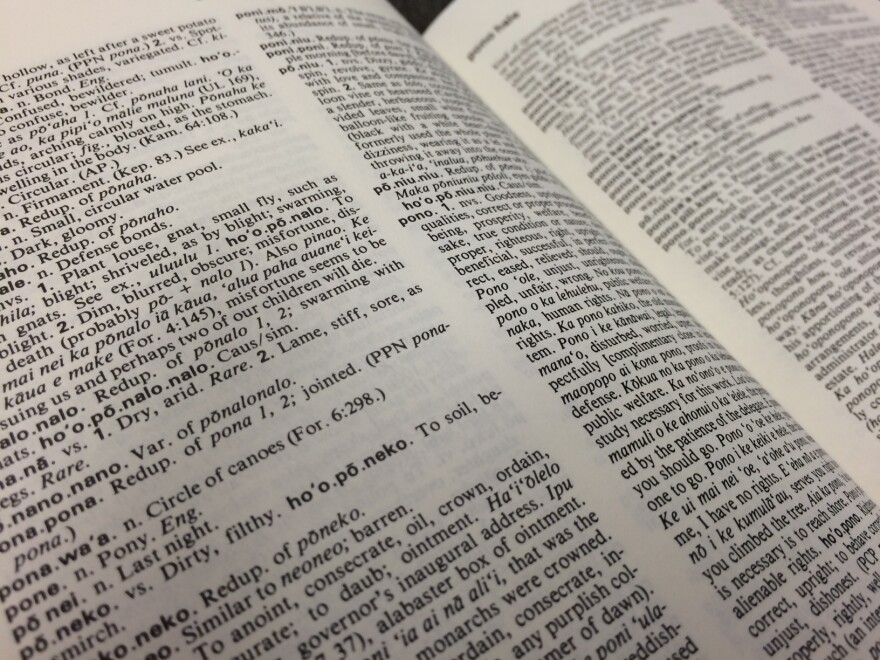This month we are celebrating Mahina ʻŌlelo Month, or Hawaiian Language month. Our stories are all in ‘Ōlelo Hawaiʻi from a collection of interviews with kūpuna who were born in Kona around the turn of the 20th century.
At the time, Hawaiian was still spoken as a first language, but some kūpuna did not want their children to learn it.
As part of our continuing project with the University of Hawaiʻi at Mānoa's Center for Oral History, we're bringing you three stories from kūpuna.
Ethnic studies professor Ty Kāwika Tengan introduces the interviews and provides translations. If you listen, you'll only hear some of the Hawaiian but it may be enough to detect the difference from how the Hawaiian language is taught and spoken today.
Margaret Kamaka Spinney was born in 1910 in North Kona, where her parents wove and sold lauhala items. She talks about how her mother taught her to weave lau hala hats.
SPINNEY (interview and translation by Larry Kimura): That’s how my mother taught us. She told us that when we make our first hat, no matter what shape it was in, whether the weaving was full of holes or it had a lot of spaces in between, that didnʻt matter. But we had to burn that hat. By doing that, later on, we would know how to do it better. We would receive all this knowledge on hat making. Then you could weave whatever you wanted after that. That was how she was taught by her mother-in-law, you see my mother was a favorite of my grandparents — or her parents-in-law. She was also taught about sewing patchwork quilts and quilting, too. But she didnʻt really care for sewing patchwork quilts. What she really liked to do was weave lau hala. And because she liked to do this work so much, she planted several acres with lau hala. This would be the lau hala kōkalaʻole.
Fred Iona was born in 1899 in Pahoehoe, South Kona. He started farming when he was young, later acquiring land, where he cultivated ʻawa, banana, macadamia nuts and peanuts.
IONA (interview and translation by Ray Kala Enos): Before, the area was filled with people who would carve canoes. In the mountains, my uncle made canoes. That's how it was when I was young. We used to climb the mountains to cut the koa. If the ʻelepaio came and picked at the tree then there would be holes. I don't see it anymore. The canoe carving experts would watch [the birds peck] and say which tree was good to carve. Then after some months, it would be dragged down. Before dragging, people behind would protect the wood and guide it down.
Amoe Giugni was born in Kahaluʻu, North Kona, in 1894. As a child, she learned about fishing, lau hala weaving and other Hawaiian practices.
RAY KALA ENOS, INTERVIEWER AND TRANSLATOR: What was the food like?
GIUGNI: Here, this place belonged to the king and sections of land were given. The beach was for fishermen. And ma uka for people to plant taro, and make poi. They would come down with poi and fishermen would go up with fish.
ENOS: Do you remember what parties were like then?
GIUGNI: Fish, poi, raw fish, pūlehu fish, whatever seafood was available, wana, ʻopihi, pig.
———
Kaikala Spinney, 18, is the great-grandson of Margaret Spinney who was featured first in this segment. He learned Hawaiian through classes at the charter school.
Speaking to The Conversation, he proudly shared that he learned how to weave a lau hala hat — just like his great-grandmother — thanks to classes at Hālau Kū Māna in Honolulu, which is dedicated to preserving the Native Hawaiian language and culture.
———
The interviews were conducted in 1980 and 1981. This oral history project is supported by the SHARP initiative of the National Endowment for the Humanities through the American Council of Learned Societies.
This interview aired on The Conversation on Feb. 23, 2023. The Conversation airs weekdays at 11 a.m. on HPR-1.








